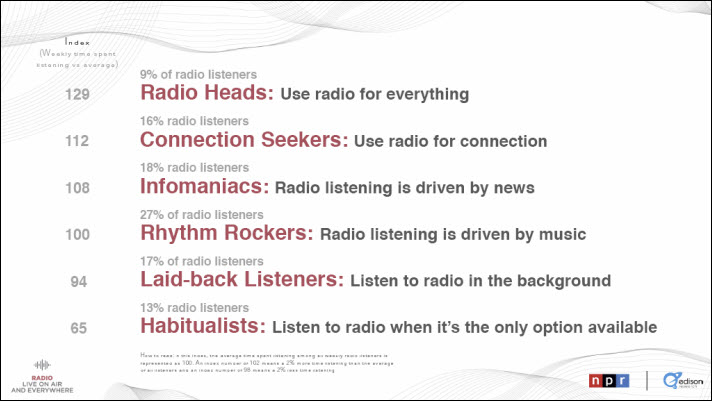I’ve got a few decades of media and marketing experience and I hunger to learn more and more.
So this summer I was catching up on my reading and found a story that talks about 6 types of radio listeners and what they want and get from listening to their favorite station.
I’ve known that there are different reasons we listen to different stations, I’ve been preaching about the difference between talk radio listeners and music radio listeners for years.
Basically, when we listen to a music station, we listen to hear our favorite songs. A radio commercial is not our favorite thing to hear on a music station, and when a music station plays 5 or more minutes of commercials in a row, we become upset. Maybe not upset enough to change to another station but mentally we tune out. Similar to when a commercial break comes on when we are watching sports on TV, many of us get up and make a trip to the bathroom instead of paying attention to the ads.
Talk radio stations, like the one I’ve been with since 2013, WOWO are a different animal. We listen to hear the words people are saying. So when a commercial comes on, it’s not that big of a deal. Also when the ad is done by the radio personality that we are listening to, it adds extra power to that ad, as an endorsement or testimonial by the WOWO radio personality.
This is what I’ve been telling business owners for years and now I have even more information to share.
To get a deeper understanding of today’s radio listeners, Edison Research and NPR teamed up on a study that segments the radio audience based on what motivates their listening, their engagement with what they hear and what they’re getting from the medium.
Radio Heads (9% of radio listeners) Use AM/FM radio for everything
These are radio’s most engaged and heaviest listeners, using it for virtually all of their audio needs: music, news, personalities/talk, and sports. More likely to be female and under 54, they over-index in listeners who are African American. As all-around audiophiles, they go way beyond the AM/FM dial – 43% also listened to radio on their smartphone, 30% on a smart speaker and 29% on a computer in the past week. They’re advertiser-friendly – 72% typically listen to ads on AM/FM – and are more likely to be employed, have above-average income, and have attained a higher education than the average AM/FM listener.
Connection Seekers (16% of radio listeners) Listen to the radio for companionship
This group is more likely to be female, 55+ and White. Second only to Radio Heads in the amount of radio they consume, Connection Seekers over-index in listening to spoken word audio and listening at home – 64% tuned in at home in the last week. Their listening habits are similar to the average listener in the devices they use to listen to radio, and the time of day they listen. Roughly seven in ten typically listen to ads on AM/FM radio.
Infomaniacs (18% of radio listeners) Listen for their need to consume news and information
The only segment among the six where men outnumber women, Infomaniacs are open to advertisements – 65% typically listen to ads on AM/FM radio and only 35% frequently avoid them. These are morning listeners with 69% tuning in from 6-10am, the highest listening in that daypart of all the segments. They prefer spoken word – 96% listened to AM/FM radio for news, 43% for personalities/talk and 27% for sports in the last week. While they’re not exclusively NPR listeners, they index extremely high for the service. Two in three (64%) have a college degree or higher and this segment over-indexes in the high income categories.
These top 3 categories of radio listeners make up the WOWO Radio News and Talk Audience.

Here are the other 3:
Rhythm Rockers (27% of radio listeners) Listen for their need to consume music
The largest segment of radio listeners, this music-first crowd leans heavily female (61% to 39% male). The youngest of the segments – three in four are aged 18-54 – they over index in listeners who are LatinX, under-index in White listeners, and over-index in low-income categories. While more likely to use online audio services, this group is also more apt to say radio keeps them company in the car.
Laidback Listeners (17% of radio listeners) Listen to radio only in the background
Skewing older and White, these radio-centric listeners are less likely to use other audio platforms and prefer listening via a traditional AM/FM receiver. They prefer music over spoken word and are more apt to try to avoid ads on broadcast radio than any other group.
Habitualists (13% of radio listeners) Listen to radio when it is the only option available
Skewing older, this group is not all that interested in audio. While they are less engaged with radio, they still spent three hours listening in the past week. Preferring receivers over streaming to get their radio, this group is the most apt to try to avoid commercials.
Before joining WOWO, I worked for music radio stations. A popular Fort Wayne rock radio personality that I worked with, Doc West, was famous for saying his station was more than a radio station, it was a way of life. And I saw those passionate Rhythm Rockers who lived that slogan.
However when it comes to using a radio station to get results from advertising your business on it, my money is on WOWO. Yours should be too.
Contact me, Scott@WOWO.com for help and more information.

